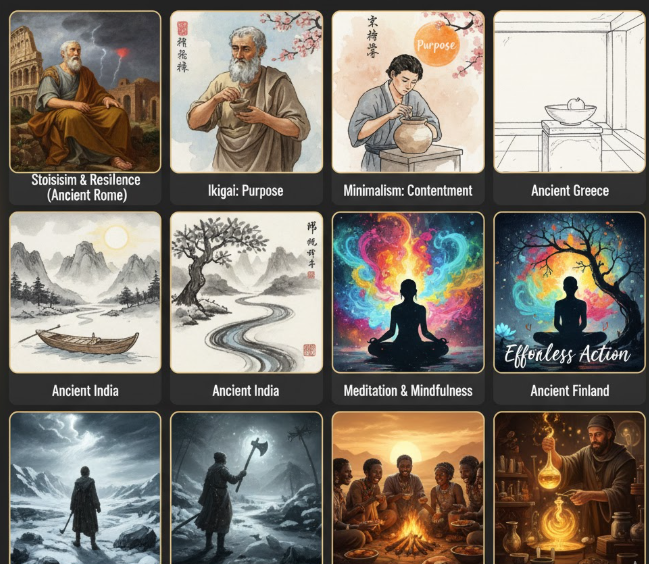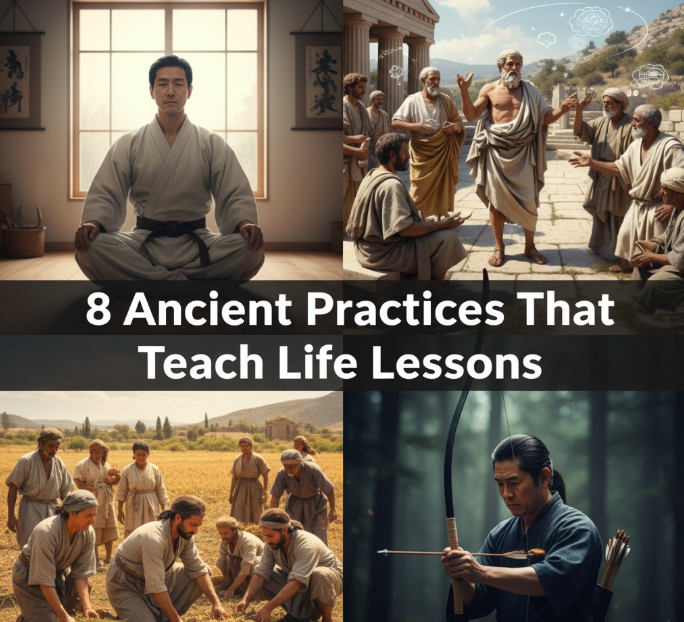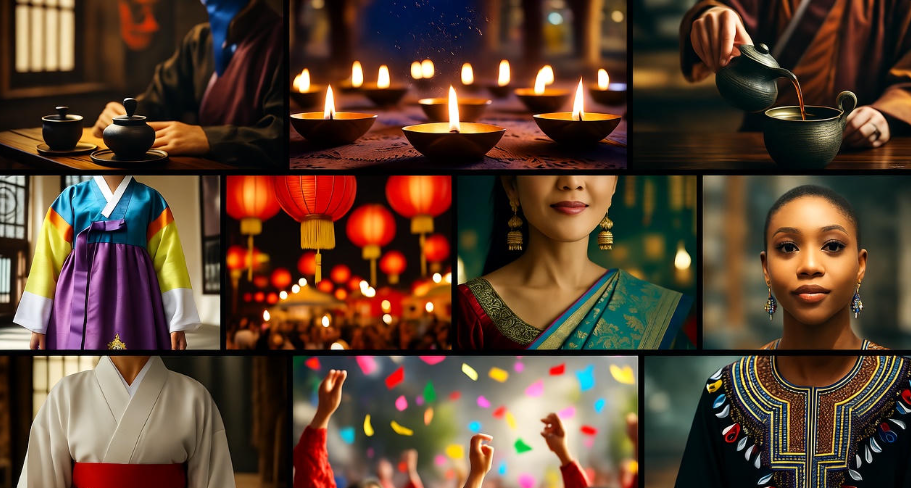Our ancestors were not scrolling through social media for guidance on this. They didn’t have motivational podcasts or self-help books piled next to their beds. But somehow they were able to live lives full of meaning, build durable communities and find tranquility in a world that we now view as much more unpredictable than the present.
The secret? They established habits — rituals, practices of mind — that lasted through time. These were not just religious services or cultural events. They were practical aids for managing stress, making difficult decisions, developing character and finding purpose.
The incredible thing is how relevant all of this ancient information seems today. These time-tested approaches will help you manage your exam stress, friendship drama and career confusion with wisdom no algorithm can match.
Let’s examine eight ancient practices that have been showing people how to live better for thousands of years — and how you can weave them into your life today.
The Stoic Morning Routine: How to Start Your Day Intentionally
The Greek and Roman Stoics had a morning routine that would make most modern self-help gurus tremble. Every day, philosophers such as Marcus Aurelius and Epictetus would quietly get ready mentally for their days.
But this was more than a positive attitude or a to-do list. The Stoics had what they called a “premeditatio malorum” — imagining what could go wrong. Sounds depressing, right? Actually, it’s genius.
How This Practice Works
The Stoics spent a few minutes each morning contemplating how their day would go. They’d ask themselves questions like:
- What opportunities might arise to disarm me today?
- What will I do if someone attacks me?
- What if my plans fall apart?
- How do I stay calm when things go wrong?
In visualizing hurdles in advance, the Stoics weren’t being pessimistic. They were getting ready to react with wisdom instead of alarm.
The Life Lesson It Teaches
These practices remind us that we can’t control what happens to us, but we most certainly can control how we respond. When you’ve already rehearsed handling a challenging situation, you’re less likely to panic when it comes to pass.
This technique is one that is used even by modern day athletes — the envisioning of success with a vision of potential problems. Students who focus on feeling calm feel less anxious and do no better than those who think negatively.
Test It Out: Tomorrow morning, take five minutes to think about your day. Don’t just fantasize about everything working out. Ask yourself: “What could be difficult today, and how will I respond with grace and wisdom?”
The Japanese Tradition of Kintsugi: Finding Beauty in Broken Things
In 15th-century Japan, a shogun shattered his favorite tea bowl. He wasn’t happy when a pair of craftsmen repaired it with ugly metal staples. So Japanese craftsmen came up with a new approach: They began repairing broken pottery using lacquer, mixed with gold, silver or platinum.
This practice is called kintsugi, or “golden joinery.” Rather than concealing the cracks, kintsugi—in which many types of objects can be dipped and coated—turns them into the most beautiful part of the object. The shattered bowl is worth more than it was before being smashed.
The Philosophy Behind the Practice
Kintsugi is based on the Japanese philosophy of wabi-sabi, which seeks beauty in imperfection and embraces the mantle of aging. It is also related to the concept of “mottainai,” or regret over waste.
But there’s something deeper here. Kintsugi artists see the act of repair as part of an object’s history, not something to disguise.
The Life Lesson It Teaches
We all break sometimes. We have tests that we fail, friends whom we lose, great errors that we make or experience pain. The prevailing culture tells us to cover these “cracks” — to fake perfection or be embarrassed about our efforts.
Kintsugi teaches the opposite. You shouldn’t be hiding your struggles, failures and painful experiences. They’re your greatest and those golden cracks become them.
If you’ve never had a struggle, then you’re a shallow person anyway. The individual who has struggled and grown also comes to be wise, compassionate, and strong.
Native American Vision Quest: You Are More Than What Meets the Eye
Vision quest is a rite of passage that has been done by Native American tribes across North America for thousands of years. They would hunger for days in the wilderness, seeking guidance about their role in life.
This wasn’t a holiday or a camping trip. It was an extreme, scary form of solitude and silence and self-discovery.
What Goes On During a Vision Quest
The details differed between tribes, but the general outline was much the same:
- The person would venture alone into a secluded natural setting
- They would refrain from eating (or eat very little) for days
- They would pray, meditate and wait for a vision or revelation
- They would come back and tell the community what they learned
- Elders would guide interpretation
In the solitude and stillness of that experience, away from all distractions, people would often make some amazing discovery about themselves and what they needed to do in life.
The Life Lesson It Teaches
In our overconnected age, we are never free to be alone with our thoughts. But there is always another notification, another video, another distraction. We can live years, and not even know to ask the question: “Who am I? What do I care about? What kind of person do I want to be?”
Vision quests remind us that true self-discovery is born of silence and solitude. You can’t arrive at who you are if you’re constantly taking in other people’s thoughts and opinions.
You won’t have to fast in the wilderness for days (unless that’s your thing). But you do need regular stretches of alone time, unscreened and uninterrupted, to truly reflect on your life. And even just an hour walk alone in nature with no phone can be transformative.
Loving-Kindness Meditation: Training Your Heart
Some 2,500 years ago, Buddhist monks invented a meditation practice known as “metta bhavana,” the purpose of which is to transform anger into love. This simple yet potent practice has been helping people learn how to feel compassion — for both others and themselves.
The Traditional Practice
The practice of loving-kindness meditation is to sit quietly and, with your eyes closed, direct phrases of goodwill toward different people.
First, send these wishes to yourself: “May I be happy. May I be healthy. May I be safe. May I live with ease.”
You next send streams of well-wishing outward in circles:
- Someone you love
- An outsider (someone you barely know)
- Somebody you struggle with or do not like
- Eventually, all living beings
The Life Lesson It Teaches
The act of doing this imparts several deep lessons about what it means to be human:
You cannot give that which you do not possess. Getting real with yourself, you’ll start to see self-compassion is not self-centered — it’s source for true compassion toward others.
Happiness isn’t a limited resource. It costs you nothing to want good things for other people. In fact, it gives you greater joy.
Resentment only does damage to yourself. When you cultivate that wish even for those who have treated you harmfully, it is not as if by doing so, you are excusing what they did. You’re setting yourself free of the poison of hate.
Modern neuroscience backs this up. Research indicates that doing loving-kindness meditation regularly will even change your brain in a way that makes you more compassionate, less anxious and better at controlling emotions. Learn more about the science of meditation and its benefits.

The Socratic Method: Learning Through Questions
In ancient Athens, a philosopher by the name of Socrates used to go around asking people questions. He didn’t lecture. He didn’t pretend to have all the answers. He would just ask question after question, and he’d turn the questions back on people and uncover contradictions in their thinking.
That became the Socratic Method, and it has educated people in critical thinking for more than 2,000 years.
How Socrates Taught
Think of the person who asserts: “We should always tell the truth.”
Socrates wouldn’t argue. He’d ask: “Always? What if speaking the truth led to getting an innocent person killed?”
“Well, maybe not always…”
“So there are exceptions? How do we know when to make exceptions and when not?”
Socrates used questioning to get people to think harder and find their own answers.
The Life Lesson It Teaches
The Socratic Method reminds us that true learning is not about memorizing answers; it’s about asking better questions.
The next time you have a tough call to make, don’t just ask “What should I do?” Ask:
- Why do I believe this is the correct decision?
- What assumptions am I making?
- What would someone who disagreed with me say?
- What would others think of this choice?
This habit also instills intellectual humility. Socrates once offered that the only thing we know for certain is how little we actually know. Smart people know how little they know.
When talking, practice centering conversations around actually asking one another questions and not simply waiting for your chance to talk. You will be more learned, and people will value you more.
Aboriginal Australian Walkabout: Being as Spiritual Exercise
For tens of thousands of years, Aboriginal Australians have engaged in “walkabout”—extensive overland treks on foot. As much as this was practical (food, ways of trade) it was also deeply spiritual.
The Meaning of Walkabout
Aboriginal Australians would walkabout on traditional pathways, sometimes alone while reconnecting culturally with the land they traveled and with stories of their ancestors. They weren’t random hikes — they were pilgrimages along “songlines,” tracks across the country that had been plotted in songs and stories.
Young people would sometimes go on walkabouts as part of their passage into adulthood, spending months living in the wilderness and using traditional knowledge to survive or find their way.
The Life Lesson It Teaches
Walkabout reminds us: To walk is to reflect. Some of the greatest minds in history — Aristotle, Watson and Crick, Charles Dickens – did their best thinking when on foot.
When you’re in a rut or feeling overwhelmed, sitting still and thinking harder about it won’t help. Your body and mind are not separate — moving your body physically changes your mental state.
But there’s a broader lesson as well. Walkabout is all about linking to something that’s larger than you are—whether it’s nature, your lineage or just the fact that humans have been walking this landscape for millennia.
When the world is in an upheaval, when things feel rushed or slipshod, cold and utterly meaningless to you, sometimes you just do not think your way out of it — you step one foot in front of the other until they suddenly find purchase and you are safe.
Ubuntu: You Are Because We Are (African Philosophy)
But in many African cultures, and particularly in southern Africa, there’s a philosophy encapsulated by the word “ubuntu.” This is commonly translated as “I am because we are,” or even “humanity toward others.”
Archbishop Tutu eloquently described the nature of ubuntu: “A person with ubuntu is open and available to others, does not have a feeling of insecurity when performing, exalts in his or her worth as well as that of others.”
The Ubuntu Way of Living
Ubuntu isn’t just a great idea — it’s an organizing principle for society. In ubuntu-oriented African societies:
- The consensus approach by the group, not of individual decision-making
- Community resources were shared
- An individual’s value came from relationships and contributions, not personal accomplishment
- If someone sinned, the objective was to find healing and restoration, not punishment
The well-known ubuntu greeting is “Sawubona” — which means: I see you — not only your physical image, but I recognize your humanity and dignity.
The Life Lesson It Teaches
Western culture is quick to celebrate radical individualism: Depend on no one; stand out, compete and win. Ubuntu presents an alternative vision: who you are and what you are, is directly related to your connections and impacts on others.
This does not mean you disappear in the group. It’s acknowledging that humans are fundamentally relational. You would not even be alive if other human beings didn’t exist. Your language, your concepts, your abilities all were provided by others.
When you succeed, it’s not only you who are successful but teachers and family and friends and hundreds of others who have buoyed your success. When somebody else wins, it doesn’t mean you lose.
Ubuntu teaches us that empathy and compassion are not a weakness — they are what makes us human. In a world that’s so often lonely and isolating, with its pervasive sense of competition, this is the voice of ubuntu telling us: we are made for one another, and we need one another and not only can that be all right — it’s beautiful.
The Virtue of Wuwei: Free Will Without Forcing It
Ancient Chinese Taoist philosophers came up with a concept known as “wuwei,” which has been translated in different ways including “effortless action” or “non-doing.” This is a weird thing to say — how do you act without acting?
What Wuwei Really Means
Wuwei doesn’t mean being lazy, or passive. It is about going with the flow, not against it. Consider how water moves around a rock — it’s not fighting or pushing, but just after the passage of time, mountains have been formed.
As the classic Taoist text, the Tao Te Ching says: “The master does nothing, but leaves nothing undone.”
Ancient Taoists were great observers of nature: bamboo bends in the wind rather than breaking. Rivers naturally seek the path of least resistance. Trees don’t try and grow, they just react to sun and rain.
The Life Lesson It Teaches
It probably comes as no surprise that modern life often feels like a perpetual struggle. We go to extremes when we’re exhausted, force ourselves against our natural rhythms and worry about controlling it all.
Wuwei teaches something else: Work with your nature, not against it.
If you’re a night owl, stop trying to be a morning person — organize your life around that rhythm when you can. If you can’t figure something out, sometimes the solution is to stop pushing and let your unconscious mind do its work.
This is not about throwing in the towel when things are tough. It means recognizing the difference between productive work and self-defeating struggle.
A plant grows with effort, but it doesn’t pull and push. A master athlete makes hard moves look easy. So a good conversation is natural and organic without it feeling pushed.
Wuwei says the way to accomplish what can seem impossible is by making use of natural flow, and that when you are doing what is effective behavior, it feels like no effort at all because you’re working in accordance with reality rather than struggling against it.
Ancient Wisdom, Modern Life
These eight practices span different continents, epochs and cultures. Yet they share common themes:
Perspective matters more than circumstances. Kintsugi artists, the Stoics and Ubuntu philosophy all preach that our experience of things is more dependent on how things appear to us than on the things themselves.
Self-knowledge is essential. Vision quests, the Socratic Method and loving-kindness meditation each direct you toward knowing yourself better.
We’re connected to something larger. Whether through Aboriginal connection to the land, Ubuntu’s concern with community or Taoist harmony with nature, these practices wake us from the narcissism that makes us feel disconnected and makes our existence feel like driftwood.
Simple doesn’t mean easy. None of these habits are challenging, but they all take discipline and persistence.
You needn’t take up all eight practices. Begin with one that resonates for you. Use it for a full month, and see what happens.
These ancient practices have endured because they are effective. They have helped billions of people to confront fear, find a purpose in life, develop a strong character and live meaningful lives. They can do the same for you — not because they are exotic or mystical, but because they treat truths about human nature that never change.

Frequently Asked Questions
How long does it take to start seeing results from these ancient practices?
This will be different for everyone and takes practice, generally around 2-3 weeks of consistent effort. Loving-kindness meditation could make you feel calmer within days; using Stoic morning reflection or the Socratic method comes easier after a few weeks. The magic is in the consistency — doing it every so often does not produce the same change. Imagine this as building muscle: no one can see the difference after just one workout, but fast forward a month and the difference is clear for everyone to see.
Can I even do these if I’m not from the original culture?
Yes, with respect and understanding. These are practices that have become part of universal human wisdom, but one should be aware not to claim them as your own creation. Learn some cultural context, practice these things with humility and don’t use these traditions like they are trendy accessories. The Native American vision quest, for example, should be especially revered in memory — consider it a template to create your own practice of solitude rather than to co-opt sacred rites.
Is there any special equipment or training that I need to do this?
No. One of the great things about these practices is that they are simple. You don’t need apps, gear, teachers or memberships. It only takes 5 minutes and your own thoughts. Loving-kindness meditation requires nothing more than a quiet place. Walking costs nothing. The Socratic Method is simply a matter of asking better questions. Begin from what you have, where you are.
Where should I begin if I am feeling overwhelmed?
If you feel stressed or anxious, then either Stoic morning reflection or loving-kindness meditation can be a good place to begin for you. Both contribute to making mental space and peace. If you know that you feel lost or confused about your way forward, experiment with regular solo walks (à la walkabout) or make quiet and alone time for self-reflection (like a vision quest). And if social connections are tough, Ubuntu philosophy and loving-kindness meditation promote both connection and compassion.
Can teens and younger people really benefit from these ancient practices?
Absolutely. Indeed, it is often the young that gain most, since they are forming habits to last a lifetime. The Stoicism way is good for exam stress and also social anxiety. The Socratic Method enhances critical thinking and decision making. Ubuntu philosophy offers a cure for toxic individualism and social media comparison. And maybe, with the unique pressures of modern digital life, these practices are especially relevant to young people.
How do these ideas fall in line with current psychology and science?
Remarkably well. We now know with modern neuroscience that loving-kindness meditation actually changes the structure of the brain. Stoic philosophy is the basis for cognitive behavioral therapy. Studies on flow states buttress the wuwei concept. Studies demonstrate that walking is conducive to creativity and problem-solving. The African ubuntu model resonates with the attachment theory and research on human relations. Those ancient traditions endured because they’re rooted in real psychological truths, recently ratified by science.




